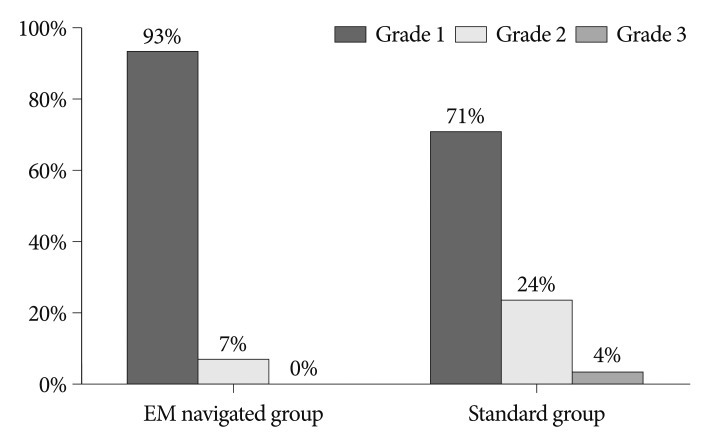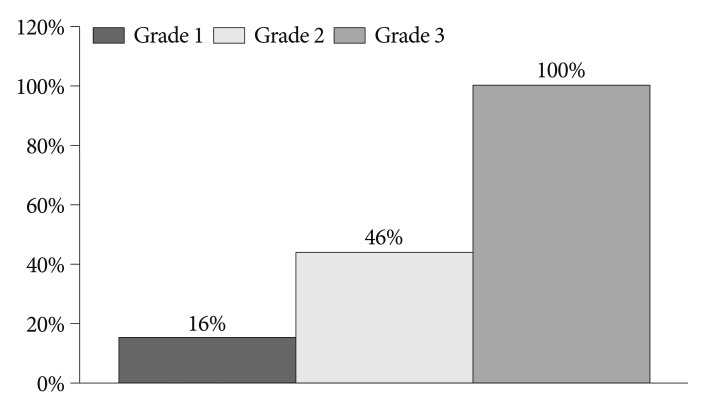J Korean Neurosurg Soc.
2013 Mar;53(3):150-154. 10.3340/jkns.2013.53.3.150.
Effect of Electromagnetic Navigated Ventriculoperitoneal Shunt Placement on Failure Rates
- Affiliations
-
- 1Department of Neurosurgery, Dongsan Medical Center, Keimyung University College of Medicine, Daegu, Korea. dongwon@dsmc.or.kr
- KMID: 2190743
- DOI: http://doi.org/10.3340/jkns.2013.53.3.150
Abstract
OBJECTIVE
To evaluate the effect of electromagnetic (EM) navigation system on ventriculoperitoneal (VP) shunt failure rate through comparing the result of standard shunt placement.
METHODS
All patients undergoing VP shunt from October 2007 to September 2010 were included in this retrospective study. The first group received shunt surgery using EM navigation. The second group had catheters inserted using manual method with anatomical landmark. The relationship between proximal catheter position and shunt revision rate was evaluated using postoperative computed tomography by a 3-point scale. 1) Grade I; optimal position free-floating in cerebrospinal fluid, 2) Grade II; touching choroid or ventricular wall, 3) Grade III; tip within parenchyma.
RESULTS
A total of 72 patients were participated, 27 with EM navigated shunts and 45 with standard shunts. Grade I was found in 25 patients from group 1 and 32 patients from group 2. Only 2 patients without use of navigation belonged to grade III. Proximal obstruction took place 7% in grade I, 15% in grade II and 100% in grade III. Shunt revision occurred in 11% of group 1 and 31% of group 2. Compared in terms of proximal catheter position, there was growing trend of revision rate according to increase of grade on each group. Although infection rate was similar between both groups, the result had no statistical meaning (p=0.905, chi-square test).
CONCLUSION
The use of EM navigation in routine shunt surgery can eliminate poor shunt placement resulting in a dramatic reduction in failure rates.
MeSH Terms
Figure
Cited by 1 articles
-
Adjustable Ghajar Guide Technique for Accurate Placement of Ventricular Catheters: A Pilot Study
Sang-Youl Yoon, Youngseok Kwak, Jaechan Park
J Korean Neurosurg Soc. 2017;60(5):604-609. doi: 10.3340/jkns.2016.1011.004.
Reference
-
1. Azeem SS, Origitano TC. Ventricular catheter placement with a frameless neuronavigational system : a 1-year experience. Neurosurgery. 2007; 60(4 Suppl 2):243–247. discussion 247-248. PMID: 17415159.2. Bierbrauer KS, Storrs BB, McLone DG, Tomita T, Dauser R. A prospective, randomized study of shunt function and infections as a function of shunt placement. Pediatr Neurosurg. 1990-1991; 16:287–291. PMID: 2134737.
Article3. Browd SR, Ragel BT, Gottfried ON, Kestle JR. Failure of cerebrospinal fluid shunts : part I : Obstruction and mechanical failure. Pediatr Neurol. 2006; 34:83–92. PMID: 16458818.
Article4. Cho TH, Park JY, Lee JK, Park YK, Chung HS, Lee KC, et al. Radiologic location of ventricular tip and the patency of ventriculoperitoneal shunt. J Korean Neurosurg Soc. 1997; 26:513–517.5. Choudhury AR. Avoidable factors that contribute to the complications of ventriculoperitoneal shunt in childhood hydrocephalus. Childs Nerv Syst. 1990; 6:346–349. PMID: 2257549.
Article6. Collins P, Hockley AD, Woollam DH. Surface ultrastructure of tissues occluding ventricular catheters. J Neurosurg. 1978; 48:609–613. PMID: 632885.
Article7. Dickerman RD, McConathy WJ, Morgan J, Stevens QE, Jolley JT, Schneider S, et al. Failure rate of frontal versus parietal approaches for proximal catheter placement in ventriculoperitoneal shunts : revisited. J Clin Neurosci. 2005; 12:781–783. PMID: 16165363.
Article8. Gil Z, Siomin V, Beni-Adani L, Sira B, Constantini S. Ventricular catheter placement in children with hydrocephalus and small ventricles : the use of a frameless neuronavigation system. Childs Nerv Syst. 2002; 18:26–29. PMID: 11935240.
Article10. Hakim S. Observations on the physiopathology of the CSF pulse and prevention of ventricular catheter obstruction in valve shunts. Dev Med Child Neurol Suppl. 1969; 20:42–48. PMID: 5263250.
Article11. Hayhurst C, Beems T, Jenkinson MD, Byrne P, Clark S, Kandasamy J, et al. Effect of electromagnetic-navigated shunt placement on failure rates : a prospective multicenter study. J Neurosurg. 2010; 113:1273–1278. PMID: 20397892.
Article12. Kang JK, Lee IW. Long-term follow-up of shunting therapy. Childs Nerv Syst. 1999; 15:711–717. PMID: 10603012.
Article13. Kestle JR, Drake JM, Cochrane DD, Milner R, Walker ML, Abbott R 3rd, et al. Lack of benefit of endoscopic ventriculoperitoneal shunt insertion : a multicenter randomized trial. J Neurosurg. 2003; 98:284–290. PMID: 12593612.
Article14. Lazareff JA, Peacock W, Holly L, Ver Halen J, Wong A, Olmstead C. Multiple shunt failures : an analysis of relevant factors. Childs Nerv Syst. 1998; 14:271–275. PMID: 9694339.15. Pang D, Grabb PA. Accurate placement of coronal ventricular catheter using stereotactic coordinate-guided free-hand passage. Technical note. J Neurosurg. 1994; 80:750–755. PMID: 8151359.
Article16. Rhoten RL, Luciano MG, Barnett GH. Computer-assisted endoscopy for neurosurgical procedures : technical note. Neurosurgery. 1997; 40:632–637. discussion 638. PMID: 9055308.
Article17. Sekhar LN, Moossy J, Guthkelch AN. Malfunctioning ventriculoperitoneal shunts. Clinical and pathological features. J Neurosurg. 1982; 56:411–416. PMID: 7057239.18. Serlo W, Heikkinen E, Saukkonen AL, von Wendt L. Classification and management of the slit ventricle syndrome. Childs Nerv Syst. 1985; 1:194–199. PMID: 4064018.
Article19. Stein SC, Guo W. Have we made progress in preventing shunt failure? A critical analysis. J Neurosurg Pediatr. 2008; 1:40–47. PMID: 18352802.
Article20. Stieglitz LH, Giordano M, Samii M, Luedemann WO. A new tool for frameless stereotactic placement of ventricular catheters. Neurosurgery. 2010; 67(3 Suppl Operative):ons131–ons135. discussion ons135. PMID: 20679938.
Article21. Tuli S, Drake J, Lawless J, Wigg M, Lamberti-Pasculli M. Risk factors for repeated cerebrospinal shunt failures in pediatric patients with hydrocephalus. J Neurosurg. 2000; 92:31–38. PMID: 10616079.
Article22. Tuli S, O'Hayon B, Drake J, Clarke M, Kestle J. Change in ventricular size and effect of ventricular catheter placement in pediatric patients with shunted hydrocephalus. Neurosurgery. 1999; 45:1329–1333. discussion 1333-1335. PMID: 10598700.
Article23. Tulipan N, Lavin PJ, Copeland M. Stereotactic ventriculoperitoneal shunt for idiopathic intracranial hypertension : technical note. Neurosurgery. 1998; 43:175–176. discussion 176-177. PMID: 9657208.
Article
- Full Text Links
- Actions
-
Cited
- CITED
-
- Close
- Share
- Similar articles
-
- Ventriculoperitoneal Shunt Complicated by Ascitis and Hydrothorax
- Laparoscopic Ventriculoperitoneal Shunt Placement in Hydrocephalus
- Acute Shunt Malfunction Caused by Percutaneous Endoscopic Gastrostomy without Shunt Infection
- Asymptomatic Fracture of a Distal Shunt Catheter after Ventriculoperitoneal Shunt for Post-traumatic Hydrocephalus
- Isolated Lateral Ventricle after V-P Shunt





